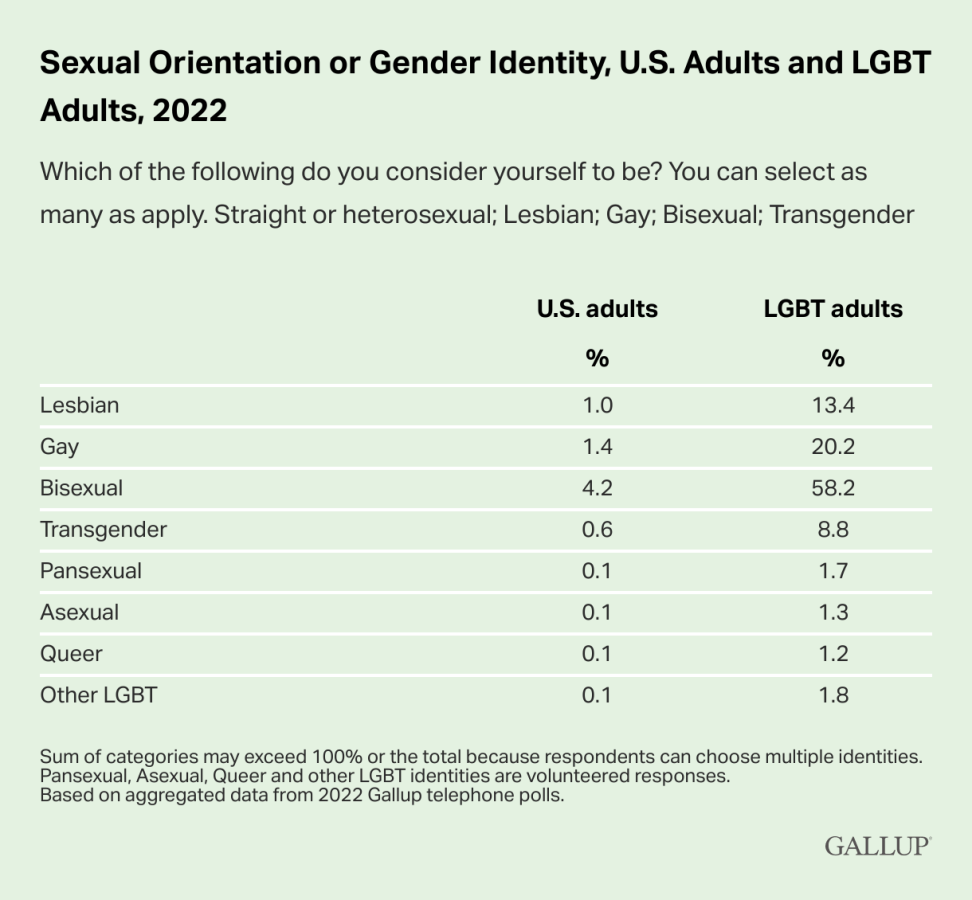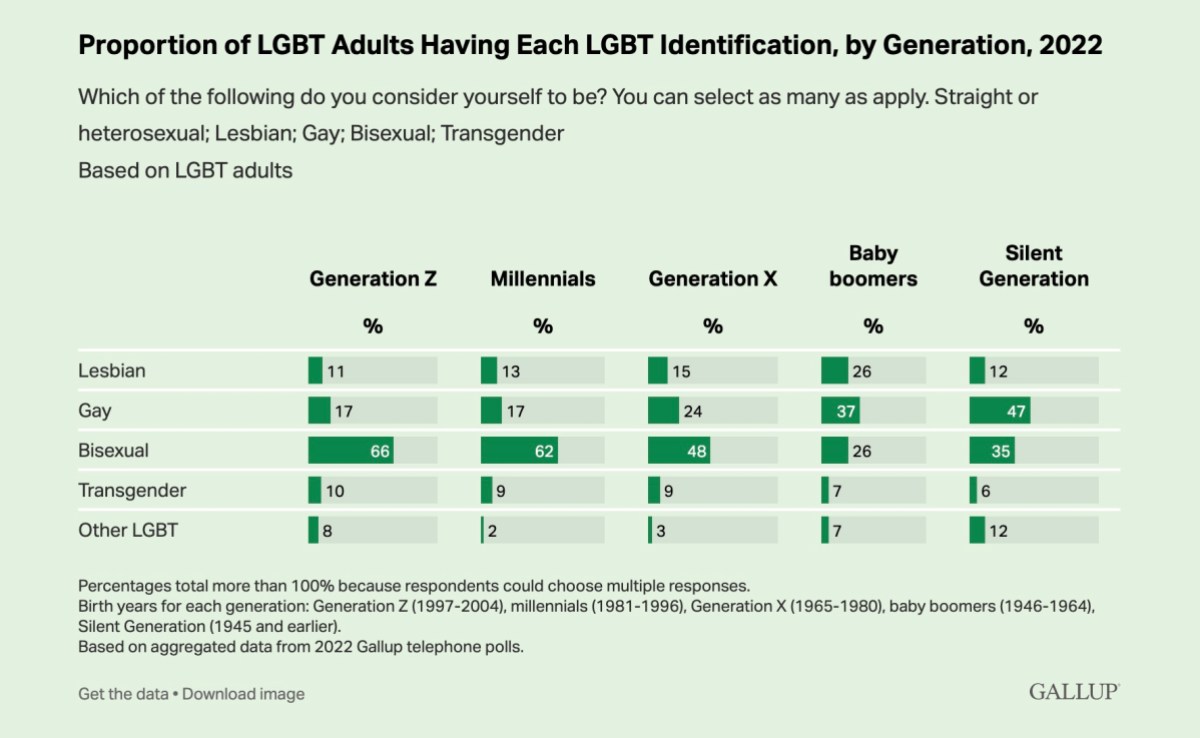Gallup’s most recent report on the number of “lesbian, gay, bisexual, transgender or something other than heterosexual” human beings in the U.S. has been released and it turns out that although it certainly feels like everybody ought to be gay by now, that is not in fact true: just like last year, only 7.2% of the population said they were LGBT.
This comes after notable increases in 2020 and 2021, which were prime years for re-evaluating your life, your choices, your gender and your sexuality. Furthermore, the younger you are, the more likely you are to identify as LGBTQ+.
U.S. adults’ identification as lesbian, gay, bisexual, transgender or something other than heterosexual held steady in 2022, at 7.2%. The current percentage is double what it was when Gallup first measured LGBT identification a decade ago. pic.twitter.com/R9KZJqoP9z
— GallupNews (@GallupNews) February 22, 2023
Over 10,000 U.S. adults were asked, via Gallup telephone survey, if they identify as “lesbian, gay, bisexual, transgender or something other than heterosexual.” They were allowed to pick multiple identities. This resulted in a sample size of merely 584 LGBT adults, containing a minimum quota of 75% cellphone respondents and 25% landline respondents. However, nobody called me.
Although I understand that asking about all of these identities at once gives a snapshot of the entire community, enables them to compare their results to prior data, and maintains the spirit of the acronym, there certainly are benefits to not lumping gender identity and sexual orientation into the same question. See — Gallup also revealed that 86% of U.S. adults said they were straight or heterosexual, and 7% chose not to answer the question, adding up to a total of 100%. This means that either Gallup somehow didn’t talk to any heterosexual or “I don’t want to answer the question” trans people, or that Gallup didn’t offer trans people the option to identify as heterosexual, which is kinda problematic!
The Future is Gay
Unsurprisingly, the youths were much more likely to be LGBT+ than their parents, which suggests that over time our numbers could increase to the point where 20% of the overall population is LGBTQ+! Wouldn’t that be fun, I wonder if our television shows would still get cancelled.

Adult members of Generation Z (born between 1997 and 2004) were most likely of all age-based subgroups to identify as LGBT. I actually wonder if these numbers could be higher in actuality, because I don’t know that Generation Z is big into picking up the phone when its an unknown number. 11.2% of millennials and 3.3% or less of older generations copped to being a member of world’s coolest community (LGBTQ+).
The number of Gen Zers who identify as LGBTQ increased significantly from 10.5% in 2017 to 20.8% in 2021, at which point Gallup senior editor Jeffery Jones noted, “They’ve really grown up in a culture where being LGBT was normal and not something that people had to be embarrassed about or try and hide. Certainly there’s still some discrimination, but it’s nothing like it’s been when the older generations were growing up … it’s both things happening — the behaviors and the attitudes are changing, and it’s also the population changing.”
Most LGBTQ+ Adults Are Bisexual
Of all the letters, B remains the most popular — more than half of respondents who said they were LGBTQ+ said they were bisexual. It’s also, unlike “lesbian” and “gay,” the only specific sexual orientation option on the survey without any gendered connotations, so its popularity is unsurprising. That said, even if you add all the gays and lesbians together, bisexuality still outpaces both.

via gallup
I’m assuming Gallup attempted to reach gender parity with this survey, but would love to know for sure! Also, are there more gay men than lesbian women in the world? Or did a lot of women and non-binary people pick “gay” as their sexual orientation?
Bisexuality was also the most popular identity amongst LGBTQ Generation Z’ers, Millenials and Generation Xers. But once we get to the Baby Boomers, those numbers shift: 26% of LGBTQ respondents are lesbians, 37% are gay, and only 26% are bisexual. This is even more stark in ‘The Silent Generation” — 12% are lesbians, 47% are gay and 35% are bisexual.

via gallup
Surprisingly, the Silent Generation had the highest proportion of “other LGBT”, with 12% of LGBTQ+ Adults choosing that option, compared to a low of 2% of millennials opting out of the offered labels. (Despite the popular conception that “queer’ is incredibly popular amongst Millenials and Gen Z!) I am dying to know if there are a lot of septuagenarians identifying as pansexual or if that group was just more likely to eschew labels altogether.
In conclusion, I would like to remind everybody of my favorite Gallup poll of all time, which was in 2011, and revealed that most Americans think 25% of the overall population is gay. I wonder what those numbers would be now, but in general it is a helpful reminder that there are no small parts, only small actors.



I’m also curious about the higher percentage of gay vs lesbian. Given the question is “Which of the following do you consider yourself to be” it certainly seems like there would be people that might select both. I know lots of women that use both pretty interchangeably, myself included, but the opposite doesn’t seem to be true.
I’ve also always wondered about lesbian as an outlier in the way it’s typically used aka “I’m a lesbian” vs “I’m gay/bi/trans/queer”. Why is lesbian commonly used as a noun vs the others that are used as adjectives? I know it contributed to my unease with the label for a while, kind of like my discomfort with being called “a Jew” vs “Jewish”. I’m not entirely sure why I prefer the adjective in the case of my queer identity though. Does anyone else struggle with this?
I think it’s simply bisexuality. Like more women are bi than gay/lez and the difference between gay and lez is more than made up for with bi women. And there’s lots of reasons for this!
Yes! It took me a lot longer to be comfortable calling myself a lesbian as a noun than gay as an adjective. I’m still more likely to say I’m gay, though I’d always pick lesbian in a survey.
100%. I love the label lesbian (and dyke!) and feel very connected to it, moreso than gay, but since gay is an adjective as opposed to a noun, I find it just flows more easily in conversation, so I’m much more likely to casually say ‘I’m gay’ than ‘I’m a lesbian.’ (Though I won’t discount that a little of that could be due to straight people’s discomfort w the word.)
All hail the bisexuals who make up our numbers! – Lesbian
Don’t want breeders to breed but there’s gotta be a way to make more gays
sigh, i do not have time to make a spreadsheet to cognitively sift through the data you have already *really* sifted through, but like, i thought about it…
always happy to see a Riese data post.
My immediate thought on seeing the title was “how did they get this data because if it was in the phone that will be a skewed see data set”.
In the UK there’s a census every few years (though it’s no longer that every household has to fill out a form so I don’t know how it really works now). In 2021 only 3.1% of the population over 16 were LGB – an even poorer result than the Gallup poll.
https://www.ons.gov.uk/peoplepopulationandcommunity/culturalidentity/sexuality